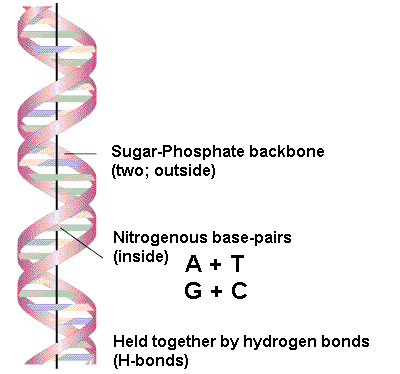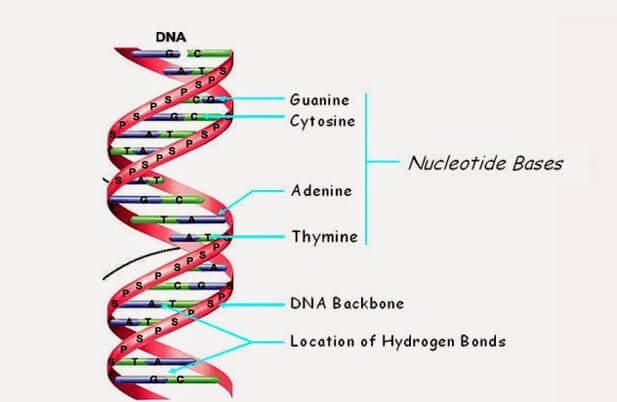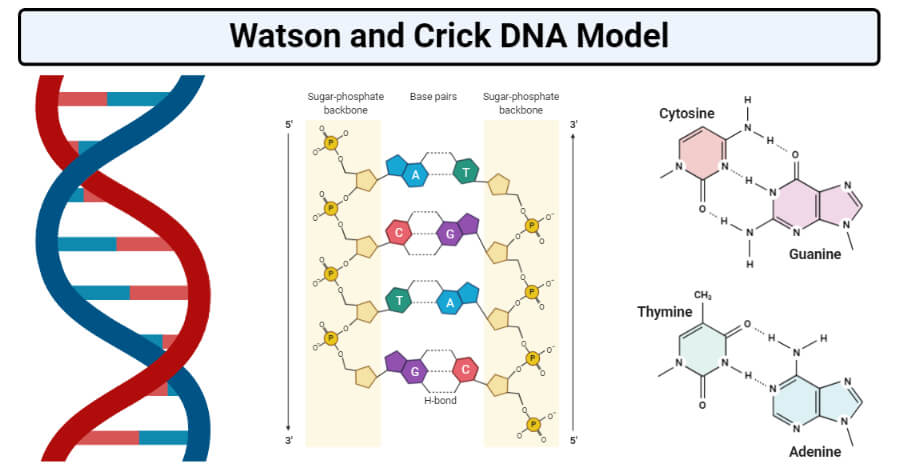Describe Watson and Crick's Model of the Dna Molecule
Describe Watson and Cricks model of the DNA molecule. It look like a twisted ladder.

Explain Watson And Crick S Model Of Dna
Crick consists of two long helical strands that are coiled to form a double helix around a central axis.

. According to Watson and Crick model of DNA. James Watson 1928 - and Francis. Find step-by-step Biology solutions and your answer to the following textbook question.
Watson and Crick built a model of DNA as a double helix. Crick 1953 proposed a double helix model for DNA molecule. Each strand is a polynucleotide chain composed of many nucleotides.
The bases are of four types A C G T. The Double Helix consists of two polynucleotide chains which are coiled like a rope in helical spiral fashion. In 1953 scientists Francis Crick and James Watson developed what we call the Watson and Crick model of DNA which supposes that DNA exists in a double-helical twisted ladder structure of phosphate chains with matching nucleotides.
Describe Watson and Crick model of DNA. By this Watson and Crick proposed a model for DNA known as Watson and Cricks model of double-helical DNA. Watson and Francis H.
Similarly G and C are found opposite to each other on the two strands and their functional groups form three hydrogen bonds that hold the strands together. The two strands of polynucleotides are run in the opposite direction and are antiparallel. Watson and Crick model of the DNA double helix Courtesy of Science Source Images.
View the full answer. Therefore because the bases are found in pairs there must be equal amounts. Pairing always occurs between A T and C G.
Each DNA molecule is comprised of two biopolymer strands coiling around each other. The model proposed that. Watson and Francis H.
Their model was consisten with both Chargaffs rules and dimension of DNA polymer provided by Franklins photograph of X. Describe Watson and Crick model of DNA class 12 biology CBSE. The DNA is the largest biomolecule which contains all the genetic information of the person to build an organism or a life form.
Watson and Crick describe structure of DNA 1953 Photo. Model of DNA molecule. Watson and Cricks model the double helix showed that the base pairs bind together in the centre of the DNA molecule.
DNA Model The three-dimensional structure of DNA first proposed by James D. After looking through Franklins data Watson and Crick were able to find that the DNA structure was a double helix with antiparallel strands which meant that the strands ran in opposite directions. It consists of two sugar-phosphate backbones on the outside held together by hydrogen bonds between pairs of nitrogenous bases on the inside.
Ii DNA molecule consist of two long stands coiled around a common imaginary central axis to form a double helix. Iii Each strand consist of number of nucleiotides. The three-dimensional structure of DNA first proposed by James D.
The three dimensional 3-D double helix model of DNA as proposed by Watson and Crick including the latest advances in its structure is. Sugar-phosphate molecules on outside paired bases on inside. A double-stranded antiparallel right-handed helix is the structure of DNA as represented in the model of Watson and Crick.
This structure was discovered by Watson and Crick. Watson and Crick proposed the model of DNA in 1953. Each pair of bases lies flat forming a rung on the ladder of the DNA molecule.
In Watson and Cricks model the two strands of the DNA double helix are held together by hydrogen bonds between nitrogenous bases on opposite strands. The X-ray diffraction picture of DNA helped Watson and Crick to further study the DNA structure and components. The DNA strands sugar-phosphate backbones make up the outside of the helix.
Two polymer strands coiled around each other are used in each DNA molecule. Crick in 1953 consists of two long helical strands that are coiled around a common axis to form a double helix. I Each DNA molecule consists of two helical polynucleotide chains or strands.
Genetic material of bacteriophage was DNA not protein. According to this model the DNA molecule consists of two strands which are connected together by hydrogen bonds an. This model for the DNA structure was widely accepted and is known as Watson and Cricks model of DNA.
Genes were probably made of DNA. In Watson and Cricks model the two strands of the DNA double helix are held together by hydrogen bonds between nitrogenous bases on opposite strands. Crick in 1953 consists of two long helical strands that are coiled around a common axis to form a double helix.
I In 1953 James Watson and Francis Crick proposed DNA structure based on X-ray crystallographic studies. Watson and Cricks model the double helix showed that the base pairs bind together in the centre of the DNA molecule. In the late nineteenth century a German biochemist found the nucleic acids long-chain polymers of nucleotides were.
DNA is a double helical structure consisting of two long strands coiled around a ventral axis. Their model has become how we view DNA the blueprint of all life ever since. Describe Watson and Cricks model of the DNA molecule.
DNA is a double helix in which two strands are wound around each other. Ii The strands run anti-parallel ie their 3-5 phosphodiester bonds are in opposite direction and the 3 end of one strand lies besides the 5 end of the other. Watson and Francis H.
Each is formed by a pentose. The Watson-Crick Model of DNA 1953 Deoxyribonucleic Acid DNA is a double-stranded helical molecule. DNAs three-dimensional structure first suggested in 1953 by James D.
The work of Rosalind Franklin and Maurice Wilkins helped Watson and Crick in their discovery of the double helix structure of DNA. Therefore because the bases are found in pairs there must be equal amounts. Base pairs arent made up of just any combination of bases.
Based on X-ray diffraction Watson and Crick in 1953 proposed double helical model of DNA.



Comments
Post a Comment